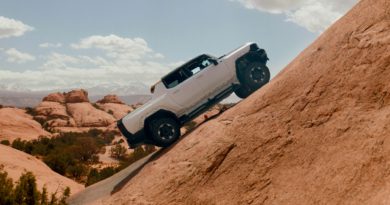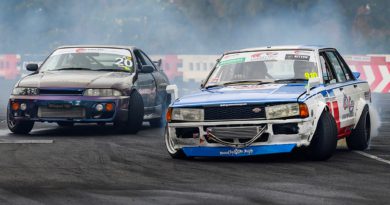Weekend rewind: Peter Glover – from karting to Formula 2
In this week’s weekend rewind, we look back to when the House Bros broke the news that leading Australian karter, Peter Glover, was moving to cars and the Australian Formula 2 Championship, a title he won in 1984 and 1985.
First published: December 1980
Words: Darren House
Photos: Ian House and Darren House – House Bros Motorsport Photography
Peter Glover, one of Australia’s most competitive and versatile kart drivers, will launch an all-out assault on the 1981 Australian Formula 2 Championship.
Glover, who began his career at the early age of 11, is one of Australia’s few professional kart drivers, rising to prominence when he became National Junior Champion at only his third meeting [he was still on P-plates at the time]. In the following eight years, Glover managed to add the Professional Driver Series, North West Victorian Titles, Dandenong Club Champion, Victorian Gold Star Championship, Karter of the Year, and Champion of Champions, to his list of successes.
In early 1979, Glover journeyed to England to check out the latest developments at the Deavinson kart factory — the Glover family business of Formula Kart Racing Centre being the Australian distributor of Deavinson products.
The Deavinson team was quick to realise the ability of the Australian ace, the reward being a works drive alongside British Champion, Mickey Allen, in the prestigious Green Man series. Not relegated to number two driver, Glover said he was given the best equipment available, identical in every way to Allen’s. Following mixed results in early rounds, the Australian was running second in the final round, ahead of series leader Paul Jackson, who only needed to maintain his third place to clinch the series. However, he apparently did not appreciate being shown the way by an unknown driver ‘from the colonies’, a driver who had become the envy of his English counterparts by achieving a works drive. According to Glover, Jackson launched him from the track in the last corner, but Jackson followed the Australian from the track, throwing away a certain series victory.
More drama followed, with the normally mild-mannered Australian saying he expressed his disapproval of the Englishman’s action by throwing Jackson and his kart into a ditch, thus earning the nickname, The Wild Australian, and the respect of the top English drivers, on and off the track.
After one month in England, Glover headed to Italy for the Jesolo invitational meeting where he was offered a drive by Bruno Grana, founder of leading engine manufacturer, IAME (Italian American Motor Engineering). However, he chose not to run, instead concentrating on repairing the Deavinson factory entry for Allen. Following a brief return to England, he had a series of demonstration runs with Deavinson in America where difficulties obtaining a licence prevented racing. Finally, it was back to Australia for the second half of the 1979 season. Despite missing many meetings, Glover managed to win the Victorian Championship, Victorian Country Championship, Dandenong Club Championship, and the Champion of Champions.
Glover has also campaigned 250 road racing (super karts) for some time with varied success and plans to further his career in this type of racing with his new Deavinson ‘double’ kart. Unlike a conventional 250 that uses a twin single twin cylinder engine, the Deavinson will use two 125cc Yamaha engines, improving handling, which Glover believes will be the machine to beat.
Having achieved almost everything possible in Australian karting and at only 23 years of age, Glover decided to move to Formula 2. He was only interested in open wheelers – saying sedans were “taxi cabs” – choosing this category due to the similarities he found between these cars and the powerful 250 road racing karts, such as power-to-weight ratio, lap times, and handling characteristics. The healthy state of Formula 2, providing good fields and plenty of competition was also appealing.
Owing to his experience in driving karts, particularly 250s, it was considered that starting in Formula Vee or Formula Ford would be a backward step.
The chassis chosen is the Brian Shead designed and built, ground effects Mk 7 Cheetah, and the most likely source of power is a Holden Gemini motor. Although unproven in Formula 2, Glover believes this engine has enormous potential because of its strength, and many of the original components can be retained. However, the final choice has not been made, and the most suitable engine at the conclusion of the 1980 season will be employed, whether it be Gemini, Ford, VW, or Toyota.
The reason for choosing Cheetah was simply the outstanding success achieved by these cars, together with their very sound construction which Glover regards as equal to any in the world. Having visited the Formula 1 teams of Lotus, March, and ATS, his opinion is not to be taken lightly.
Hopefully, Glover’s move to Formula 2 will set the pattern for other Australian kart drivers to try their hand at the ‘big time’. Whilst karting overseas has proved a popular breeding ground for Formula 1 drivers such as Ronnie Peterson, Ricardo Patrese, Elio de Angelis, Riccardo Zunino, and Alain Prost, it has not, in general, done likewise in Australia. Does this mean Australian karters are not good enough? One look at Alan Jones and Vern Schuppan should instantly answer that question.
Glover attributes the lack of top kart drivers moving into cars as being due to the comparative costs of both sectors of the sport. He believes karting is an excellent introduction to motor racing because it provides the closest, most competitive racing of any type in the world, and few people outside the sport really appreciate the ability of the drivers or the sophistication of the machines. Also, karting allows the enthusiastic, potential world champions to begin their quest for glory at the age of only seven.
Glover hopes to prove the value of his karting background when he starts campaigning the Cheetah next year. He also strongly believes top Australian karters, such as Robbie Hunter and National Champion, Drew Price, would give some of the more publicised car drivers a run for their money.
Support for the Formula 2 assault will come from Formula Kart Racing Centre, operated by Glover, his father, Bob, and uncle, Bill, in the Melbourne suburb of Dingley. The business is a success story in itself, originally preparing a few karts here and there, developing to the stage where the three of them are flat out keeping up with demand.
The good, or bad news, depending on whether you are a spectator or driver of karts, is that while Formula 2 will take priority, Glover will not be lost to karting and will continue to campaign his Deavinsons extensively in the exciting and competitive manner to which we have become accustomed.
Glover is very serious and determined in whatever he undertakes, with his philosophy being to tackle things head on and with the best equipment. His attempt on the Australia Formula 2 Championship will be no different, and he should prove to be among the most competitive drivers in the series during the year.












